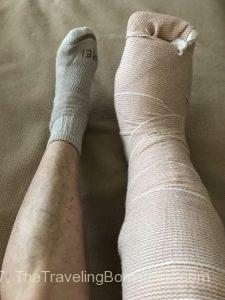
After careful consideration of surgical and non-invasive options, I consented to ganglion metatarsal bone cyst foot surgery. While I knew that none of the proposed surgical procedures offered a 100% guarantee, I was willing to go ahead with the procedure that made the most sense. For background information, see Tips for Handling Multiple Doctors’ Opinions.
Today, I will share what I learned from this foot surgery and simultaneously offer tips for people who are contemplating foot surgery or are presently going through the recovery phase.
6 POST-SURGICAL TIPS
Embrace Positivity
Use life-giving positivity to put the breaks on your negative thoughts and negative life-draining negativity. Focus on the benefits of your surgery rather than the frustrations that normally encompass a surgical procedure. It’s important that you approach the recovery phase with an upbeat attitude.
Acknowledge Pain
Everyone has a unique pain tolerance level. Each body part has a different number of nerve endings. Keep in mind that your feet have more nerve-endings per square inch than any other body part. While I was aware of this fact, I didn’t anticipate how much this foot surgery would hurt.
Yikes! My pain was disproportionate to the tiny surgical site. I had to acknowledge my limitations until my pain subsided.
Avoid Comparing Yourself to Others
Yes, it’s great to know that the average recovery time should be X number of weeks. If your rehab takes longer than anticipated, don’t get unglued. Everyone recovers at a different rate. You can look to other people’s experiences as a guide, but it’s unwise to believe that you’ll follow the same path.
Manage Your Limited Mobility
If you’re an active person, it will be harder to deal with your lack of independence. Crutches and scooters will put a crimp on your day-to-day life. Avoid getting too upset by your lack of mobility.
Gradually, increase the amount of time you spend upright. In the early stages, medical professionals recommend that you keep your foot elevated. I definitely knew when my leg was down too long. As soon as my foot started to throb intensely, I knew that I had surpassed my limit.
Focus on the long-term goal of returning to your former lifestyle. Don’t get hung up on any minor setbacks.
Traveling During the First Six Weeks
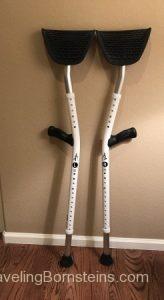
I chose to travel twice during this period. After a couple of weeks, I flew to Chicago. I didn’t feel strong enough to hop through two major airports and a large hotel. Whenever possible, I arranged for wheelchairs and reserved a handicap room. For additional information, I recommend reading Tips for Traveling With Crutches.
At about 5 ½ weeks post-op, I went on a business road trip. To limit the inevitable throbbing, I elevated my leg in the backseat of the car during the longer rides and avoided standing too long. My daily walking was kept to a minimum. I made sure that the organizers of the trip were aware of my limitations.
Patience
The length of time I spent transitioning from non-weight bearing status to partial weight-bearing to walking unassisted was unique to my situation. It was longer than the initial projection. I had no choice but to remain patient throughout this tedious process.
Was I disappointed and frustrated?
Yep. But, I persevered.
Could I do everything I wanted? No!
It was almost three months post-op before my foot cooperated and I could drive my car again.
Was it frustrating? Yes.
But I knew from past experience that I had to wait until my body was ready to move to the next level.
I viewed the recovery process as a marathon where I had to pace myself rather than a sprint that would be completed quickly.
4 REHABBING TIPS
Follow the Doctor’s Protocols
Each doctor determines his or her post-op protocols based on multiple factors. If your doctor recommends physical therapy, find a therapist who will follow through accordingly. I started physical therapy after I was weight bearing and the pain had subsided significantly. My therapist, Mike, provided a progression of exercises and also worked on my foot scar as well as the soft tissues and muscles in my foot, ankle, leg, and hip. My situation was a bit more complex since my pre-surgical foot pain prevented me from completing the physical therapy for my knee.
If physical therapy isn’t required, read about different ways that you can regain your strength, flexibility, range of motion, and stamina. After creating a plan, share your ideas with your surgeon or physician assistant to make sure that he or she agrees with your strategy. During the post-op recovery phase, you should avoid activities that could cause re-injury.
Listen to Your Body and Gradually Increase Activity Level
Once your feeling more like yourself, you’ll be prone to want to do more and more. It’s tempting. But your body will send blunt messages when you’ve overdone it. The foot pain will intensify and the toes may swell. It’s even possible that other parts of your leg may hurt. These are indications that you need to slow down your pace. A little TLC may be warranted.
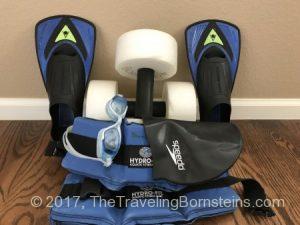
Finding the delicate balance between increasing activity levels and managing discomfort can be tricky. In some situations, non-weight bearing activities such as swimming and riding a stationary bicycle may be better than walking.
If you’ve been sedentary for a while, take it slowly as you resume activity. The first time I returned to swimming, I spent most of my time walking in the water and only five minutes of swimming. After several weeks, I was back to swimming for more than 30 minutes without stopping and doing another 30 minutes of combined aerobic activity and walking in the pool. I’ve always tried to incorporate water aerobics using Hydro Fit products, walking in the pool, and swimming with Aqua Sphere training flippers as part of my rehab process.
Due to the time needed to heal my bone graft, I was advised to avoid high impact activities for at least six months.
Ask Questions
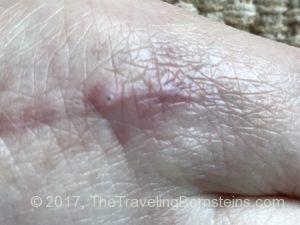
If something doesn’t seem quite right, don’t hesitate to call the doctor’s office. Just a few weeks ago, I felt like there was a sliver in my incision. I learned that it was a dissolvable stitch that was trying to come through my skin. While the surgeon offered to retrieve it, I’ve chosen to wait and see if it heals on its own.
If you’re not sure how quickly you should be increasing your activity level, call someone on your medical team. Don’t forget to ask about your individual post-surgical restrictions.
Post-Surgical Foot Gear
For the first couple of weeks, my foot was wrapped in an oversized soft cast. This apparatus made me feel off-balanced when I hopped around on crutches. As a result, I had to be extra careful so that I wouldn’t topple.
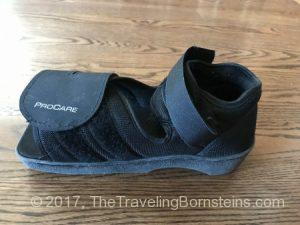
When the cast was removed, I was placed back into an orthopedic boot. It was the same one that was prescribed after my injury. I was instructed on how to use crutches so that I could be partially weight-bearing. When the pain intensified, I had to return to my previous hop status for another week or so.
Thereafter, I was able to gradually increase the weight I distributed on both of my feet. Over time, I put more and more weight on the surgical foot. At approximately five weeks, I graduated to an orthopedic shoe. This hard soles shoe was easier to navigate than the boot, but it was still a different height compared to my other shoe. This created a hobbling effect. My hip started to suffer from the unevenness of my gait.
Within a few weeks, I was once again able to move on to the next step. I was so excited to put on my previously comfortable HOKA ONE ONE shoes. These were the only shoes that I was able to wear before the surgery.
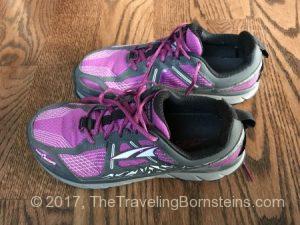
All of my HOKA ONE ONE shoes irritated the incision line on the top of my foot and increased the pain in the metatarsal region. I was frustrated.
What was I going to wear?
I looked at the composition of the post-surgical shoe and observed that it was totally flat and extremely wide. My first stop was the Boulder REI store. The shoe saleslady directed me to similarly constructed shoes. The closest match was the Lone’s Peak 3.5 trail running shoe by Altra. On the Altra website, I read about the Zero Drop™ Platform and wide toe box. I followed their recommendations to purchase a half size larger shoe. I was so happy when I tried this shoe on. It was a great fit. I walked out of the store delighted that I could walk in shoes again.
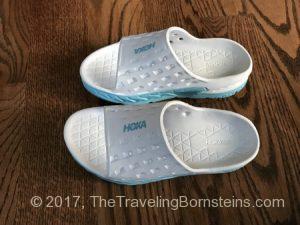
The Altra shoe solved my outdoor concerns. I still needed to find an indoor shoe because I was instructed to avoid going barefoot. While ordering shoes online can be a disastrous experience, I decided to take a gamble. I ordered the HOKA ONE ONE recovery sandal. As a former teacher, I say THUMBS UP to this shoe. To protect the incision line, I wear a pair of socks. It may look a bit funky, but I’m able to walk around the house without pain. I purchased a second pair to wear when I go swimming.
CONCLUDING THOUGHTS
I’m now four months post-op. I’m pleased with my recovery process.
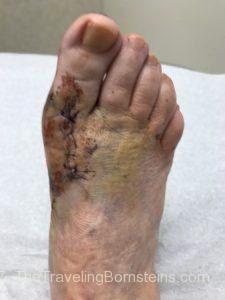
Yes, the initial few weeks were painful and challenging. In retrospect, having two orthopedic surgeries within three months of one another may not have been a wise idea. I was extremely tired and simply didn’t seem quite right.
For weeks, the top of my foot looked like someone had dropped a piano on it. The bruising covered the top half of my foot. The pain was definitely more than I anticipated. Since I rarely experience post-op bruising, I was surprised.
But, at about five weeks post-op, I rounded the corner. I was able to participate in a weeklong press trip which uplifted my spirits. This invitation provided an incentive to reach an obtainable goal. Successful rehabbing requires being motivated to reach definable milestones. After accepting the invitation to attend the media trip, I worked toward being able to walk a mile and to stand for at least 10 minutes.
To my surprise, I walked up a steep portion of the Oregon Trail. While admiring the view, I breathed in deeply. Wow! I was thrilled that I could do this at less than 6-weeks post-op. There were several participants who didn’t even try.
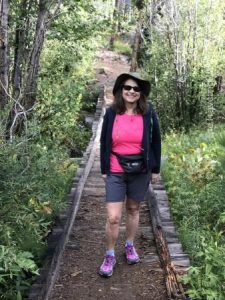
Just a few weeks later, the bruising was gone. I was able to walk an easy five-mile mountain trail. I slowed my pace when I approached the uneven rocky surfaces and the wooden footbridges that crossed small creeks. By the end of my adventure, my spirits were soaring and my foot was sore. I’ve trekked a few more times in Summit County, Colorado. Each time the foot is responding more favorably while my hip is slower to follow. Eventually, I regained all of my independence and drove my car again to Denver.
I’ve gradually increased my swimming routine to include three one-hour sessions per week and I’m walking a couple of miles in my neighborhood twice a week. While I’m still not back to my pre-injury state, I’m diligently working toward my goal of skiing this December. I missed the entire season last year due to my knee and foot injuries.
After reading a preponderance of medical studies that tie physical activity levels to longevity, I’m trudging on. Now that my knee and foot have been successfully repaired, I’m ready to go back to exploring the world and sharing my travel adventures.
RELATED POSTS
Can Your Diet Influence COVID-19 Immunity?
Why We Get Sick: Showcases Linkage Between Insulin Resistance and Chronic Illness
Active Lifestyles Versus the Aging Process
Tips For Handling Multiple Doctors’ Opinions
Should a Middle Aged Person Have Medial Meniscus Surgery?
6 Tips for Eliminating Back and Sciatica Pain
Overcoming a Physical Therapy Setback
10 Tips for Subacromial Decompression Post-Op Recovery
Meaningful Anniversary (hip replacement)
5 Ways to Improve Exercise Motivation
CAN YOU SHARE?
Each person has his or her own recovery story. We can all gain something from reading about how others handle their rehab process. Do you have any tips that you’d like to share with my readers?
BIO
Sandra Bornstein is a freelance travel and lifestyle writer. She shares her experiences and recommendations on this blog and on other websites. Check out Sandra’s second website, https://thetravelingbornsteins.com. It exclusively focuses on travel.
Sandra contributes a monthly travel tip column for Golden Living, a Best Version Media magazine. She also writes for Fareportal’s online sites—One Travel Going Places and CheapOAir Miles Away.
Sandra is the author of MAY THIS BE THE BEST YEAR OF YOUR LIFE. This memoir highlights Sandra’s living and teaching adventure in Bangalore, India. As a licensed Colorado teacher, Sandra has taught K-12 students in the United States and abroad. She also taught college-level courses.
Sandra’s memoir was a finalist in the Travel category for the 2013 Next Generation Indie Book Awards, the 2013 International Book Awards, the 2013 National Indie Book Excellence Awards, 2013 USA Best Book Awards, and an Honorable Mention award in the Multicultural Non-Fiction category for the 2013 Global ebook Awards.
I love how you talked about focusing on the benefits of the surgery rather than the frustrations. I think that my mom might have to get a toe shortening surgery. She will have to go see a doctor about it. I really want her to be positive about it if that is what happens.
Dave,
Thanks for taking time to comment. Yes, I agree that it’s always best to focus on positive aspects of a situation. Anyone contemplating a surgical procedure that isn’t in an emergency situation, should also take the time to consult with more than one doctor. One of the links at the bottom of this article is to a story that discusses how I handled multiple opinions. It’s important to explore one’s options before consenting to surgery.
Thanks for that warning about the potential pain. If I do get an ankle surgery, I will make sure to listen to my body and respond in a healthy manner. Pain isn’t always a bad sign in my opinion. It means that, in some ways, healing is going on!
Hi Sandra,
I found your article very helpful and will save it and re- read after my surgery for bunion, plantar plate tear and rotated hammer toe this coming Friday. I am determined to be positive about it and I am going to embrace the down time with writing, reading, sewing and knitting and all those craft jobs I’ve started but never finished.
I’ve invested in a light footrest and made sure there’s a good space so me to sit in every room so I don’t get claustrophobic. I’ve cleared out my garden shed and set up a zero gravity chair so that on good days I can hobble out there and sit for a while in the winter sun.
I’m under no illusions as to the pain I may have because the pain I have now is pretty bad at times but I will be using homeopathy to help recovery as it has worked really well for me in the past.
Thanks for sharing your story,it’s really very helpful.
I like the idea of the Hoka recovery shoes but I thing I may have to go with “Crocs” as I am in the UK and I don’t think I’ll be able to get them here.
I believe New Balance are a good shoe for recovery and I tried on some lightweight, non leather, Dr Martens recently which I think will work for later on, as “what shoes will I be able to wear” is a major concern!
I will update you! Thanks again and best wishes with your continued recovery.
Kind regards,
Bev Nicolaides
Bev,
Good luck with your upcoming surgery. It sounds like you are taking steps to prepare while also keeping a positive attitude. Both will help you in the long run. I sincerely hope that your procedure will eventually improve your situation. Patience is another important ingredient to the overall success of your rehab process. Take care, Sandy
I have just had bunion surgery in New Zealand. It is coming up to 4 weeks post op and starting to get a little frustrated. I had no real pain after the surgery – just discomfort. I have never had an Op before or been in Hospital apart from Maternity. Luckily it is Spring/Summer so found I had to sleep with my foot on a cushion exposed as didnt like the feel of bedding on my affected foot. This morning first time I have showered in a “normal shower” I have a Motel complex so have a disabled shower with a seat – mostly just sponge bathed unless needed to wash my hair. Pre-op I would walk the dog first thing in the morning and cycle plus be active racing around the Motel. I am pretty much off my crutches now just the Procare Shoe like Sandra had. My tip would be to buy(we got off internet for NZ$200) a wheelchair. My husband is able to push me up the road to a Cafe for lunch etc. So nice to get out from four walls. Read books binge Netflix.
Susan,
Thanks for your patience. I hope that your recovery is going well and you are able to return to most activities.Good luck. Sandy
You’ve got great tips for foot surgery recovery. I like how you said that it’s good to stay positive. That might be hard after surgery, but I’ll be sure to tell my brother that because he may need foot work done soon.
Ridley,
Best wishes for a speedy recovery to your brother for his upcoming surgery.
Sandy
My injury happened at the gym 6 weeks ago when I lifted what I didn’t know was 100lb plate. I fractured three toes. I have been given permission to walk in a shoe. It feels awkward. Its as if my foot wants to walk like it still has the post op shoe on! I’m wondering when it will go away because I just want to go to the gym and slowly get back into a routine. Thanks for sharing your story!
Khadijah,
I sincerely hope that each day is a better day. Everyone heals at their own rate so it’s not possible for another to provide any estimations for a recovery process. It’s best to follow your doctor’s advice and to proceed cautiously. Good luck!
Hi Sandra, I loved the way you shared the most important tips for recovering from foot surgery. I think the patient has to mentally strong enough to cope up with the bad days.
Brenda, Do you have experience dealing with foot surgery? If so, do you have anything to share?
You had some really great ideas and the thought of staying positive always helps. I’m working on it. Three days before my surgery to remove several bone spurs on the top of my foot and a large tumor near my toes, I fell and tore my rotator cuff and pulled a muscle in my groin as well as giving myself a huge lump on the head and 2 black eyes. My doctor did the foot surgery anyway but I do feel like I was thrown from a tall building instead of having had surgery. I’m recovering slowly from all of it because my pain is everywhere. Your article is great and it helps me see an end to this at some point. Thank you.
Roz, Your message came in when I was out of the country. I hope by now you are well on the way to a full recovery. Good Luck. Sandy
So thankful to have found this post. I had my bunion surgery on July 19. I have been in excruciating pain. So unsure of my surgeon because it’s not getting better. I didn’t come home with a cast or walking boot, just the flimsy post surgical shoe. No crutches either.
With every step I can feel my foot swelling. Praying that this is just the dark before the dawn. Finally tomorrow he is giving me the walking boot. Thank you for sharing and allowing others to as well.
I hope that your recovery is going well and that the swelling has diminished. Good luck!
What did you use when you first started swimming to help brace your foot? I had bunion correctional surgery and a tendon reattached + my navicular removed. I am an active person and my inability to workout has been killing me. I want to start swimming but I am nervous about moving my foot around too much when swimming. Help?
Hi Rebecca,
Thanks for your patience. Yes, active people struggle when they need to be in a rehab mode and cannot do everything that they want to do. Patience is the key. My surgery didn’t require any type of brace so I cannot recommend anything. I suggest asking your doctor or physical therapist. Simply walking in the pool can be the first step. Good luck in your recovery process.
Hello Sandra—Just wanted to thank you for your spot-on tips on foot surgery recovery, as I am at the end of my rope 6 weeks after a metatarsal bone fusion surgery , struggling to rise above the excruciating nerve pain I have ever experienced. Prior to the surgery, my surgeon advised me that the first 5 post op days would be painful but it would improve dramatically in the ensuing days and she said nothing about nerve pain so I was quite unprepared for the painful aftermath. The surgeon conveniently scheduled her surgeries on Thursdays and routinely uses nerve blocks to minimize pain in the first 3 days and sends her patients off with 3 days of pain medication. Predictably the pain was unbearable by Saturday night and of course the doctor couldn’t be reached. The pain meds were to run out on a Sunday night so we contacted the hospital resident to get a refill and were told by a first year resident that due to the opioid crisis, he had no authority to refill the prescription and the surgeon wouldn’t be in till Tuesday. He advised us to go to the ER an hour away if the pain didn’t improve with elevation and extra strength Tylenol . So that’s what we did and it was determined that the cast the surgeon put on was way too tight and not able to expand with the swelling so the cut into it to reduce the pain and sent me home. Since then the nerve pain has gotten worse and it’s worse at night so I ‘be been getting zero sleep which turns me into a grouchy monster the next morning. The second cast was put on crooked at 4 weeks forcing my foot to the right , putting more pressure on the incision site causing a horrible sensation of electrocution so I have not been a happy camper relying in Tylenol and 200 mg of Gabapentin daily which seems to do nothing! This past week I transitioned to a full size boot which is equally as heavy and tightly confining as the casts, but thankfully I’ve been able to remove it a couple times a day which feels 500% better , although it needs to be worn at night when the worst pain comes.I guess my number one question is, when can I expect the pain to subside because this is not what I thought I had signed up for. Going forward, per your recommendations, I will attempt to incorporate some positivity into my daily life and remind myself of the long term benefits of the surgery . I ‘m a very active type A personality so I can’t wait to get back on my feet! I’m supposed to start physical therapy this coming week which hopefully will expedite healing but with the pain and swelling I’m still experiencing it seems a bit premature. Anyway, if you have any additional suggestions , I’d love to hear from you.
Robyn, I am so sorry to hear about the difficulties you have experienced during your recovery process. I hope that by now you are doing better and that you can see the light at the end of the tunnel. Everyone’s recovery process is different. It is not possible to predict how long it will be before you are pain-free. It appears that you are very proactive and will speak up or seek medical attention if something doesn’t seem quite right. I recommend that you continue to use common sense as you go through the remaining rehab process and ask questions of your medical providers. It’s also important to remain positive. I know how hard it is to remain sedentary when you want to be active. Good luck!
I have observed this increased strength in people who exerted a little more pressure on their pain point, hence giving them an edge towards handling their pain. Example, those with shoulder injury should try everyday to touch the upper slab. Little efforts make the big differences.
Joseph, Thanks for adding a suggestion. Sandy
I love your knee injury rehab tips. My wife and I need a new doctor. That way he can tell me how to fix my knee.
Bob,
I’m glad that my tips were useful. Good luck finding a physician who can address your issues. Sandy
If I went in for foot surgery, I’d for sure follow your recovery tips. I wouldn’t want any complications to come up afterward. Following the doctors orders would be very important.
Callum, Good luck. If you need surgery, I hope you have a positive outcome. Sandy
I had surgery to correct a bunion and hammertoe last March (six months ago). I had previously had a bunionectomy in 1985 and would prefer not to have it recur a third time. I am overweight and have a habit of walking barefoot around the house, which I have read is not good. My foot still swells and causes pain intermittently.
Can anyone recommend a good slipper to wear that would support & protect the corrected foot and prevent requiring surgery in the other? I have googled women’s slippers bunionectomy post-recovery in various formats and it just gives me shoes, which is becoming very annoying.
Hi Kathleen, As I mentioned in one of my posts, the HOKA rocker sandals were a wonderful addition to my shoe wardrobe. While each person is different, I personally found that the cushioning protected my foot when I wore them inside and outside the house. I intentionally bought a size larger for inside the house so that I could wear socks with them. Sandy
I wish my doc had given me some post op instructions for a ganglion toe cyst. yo have been quite helpful Thanks
Rebecca,
I’m glad that my tips were useful. Sandy
hi I loved this article, I have put off having the surgery for 1 years due to being afraid of the down time etc
Lori, I feel fortunate that my surgery and post op recovery corrected my situation. I realize that sometimes surgical procedures do not resolve the original issue and can sometimes create other problems.Like so many things in life, nothing is ever guaranteed.
Pain can be so debilitating. While surgery is not always the appropriate response, it can be an effective way to eliminate or minimize pain.
Patience and a positive attitude go hand in hand with the recovery process. From my experience, I would rather look forward to the end of a recovery than cope with endless days of pain with little hope of improvement.
Thank you for stating that you should ask questions when getting foot surgery. My dad might have to get foot surgery. I will definitely pass along all of your great tips and information to my dad if he does end up needing surgery.
Sadie, I send my best wishes to your dad. I sincerely hope that his foot condition will resolve without the need for surgery. However, if surgery is recommended, please encourage him to follow all of the post-op instructions and to ask questions when something isn’t clear or if the recovery does not seem like it is following the doctor’s anticipated timeline.